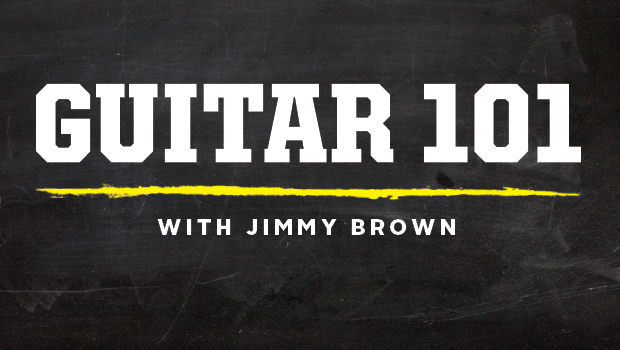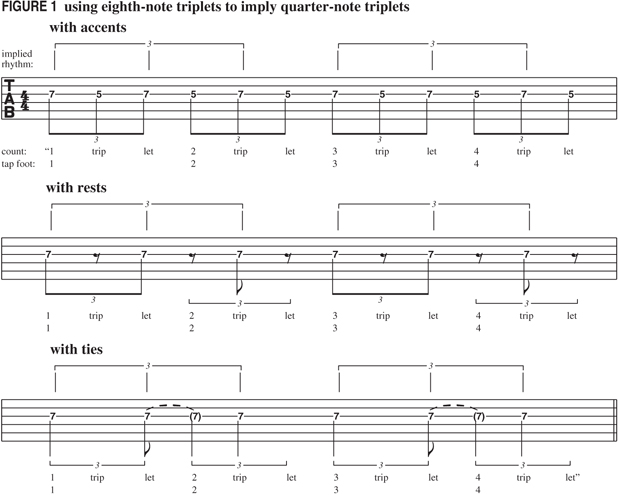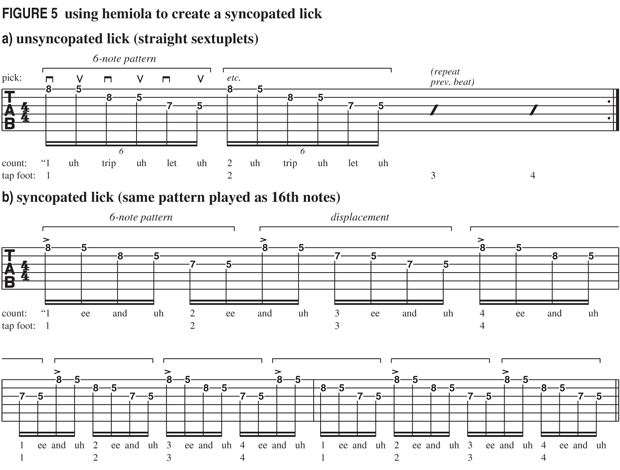Guitar 101 - Mastering Rhythm & Syncopation, Part 4: More Fun with Triplets and Hemiola

In part 3 we learned how to count and play eighth-note triplets (three evenly-spaced notes per beat). We also learned how to use a rhythmic device called hemiola to create ear-tickling syncopation effects. As you recall, we took a short, repeating pattern of eighth notes and made it sound more interesting and quirky by changing the rhythm to eighth-note triplets. Doing this caused the pattern to begin at a different place in the measure each time it's repeated (rhythmic displacement). We then used this same approach to transform a repeating pattern of four 16th notes into a psychedelic, circular lick by again changing the rhythm to eighth-note triplets. In this lesson I'm going to show you more slick hemiola tricks that will help expand your phrasing vocabulary and bolster your rhythmic skills at the same time. But first we need to cover two more commonly used triplet rhythms.
FIGURE 1 illustrates how quarter-note triplets can be implied within an eighth-note triplet rhythm by using accents, rests or ties to emphasize every other note (the implied quarter-note triplet rhythm is indicated above each measure). As you play this example, notice the "staggered" feel the implied quarter-note triplet rhythm imparts.

FIGURE 2 shows two measures of quarter-note triplets in 4/4 time. Notice that one set of quarter-note triplets takes up two beats, or half a measure (the same space as two sets of eighth-note triplets).

The hardest thing about counting and playing quarter-note triplets is tapping your foot on each beat at the same time. The easiest way to master this is to count eighth-note triplets, as indicated here, so that each quarter-note triplet falls on every other count ("1 trip let 2 trip let 3 trip let 4 trip let"). This will enable you to determine exactly when to tap your foot and when to play.
Going in the opposite direction (getting "smaller"), 16th-note triplets are three evenly-spaced notes played in the space of one eighth note (see FIGURE 3). As this example demonstrates, in a measure of 4/4 time you can have two sets of 16th-note triplets per beat-one for each eighth note.

There is no standard way of counting 16th-note triplets. Many musicians borrow the syllables used for counting eighth-note triplets and count "1-trip-let and-trip-let, 2-trip-let and-trip-let, 3-trip-let and-trip-let, 4-trip-let and-trip-let, 1-trip-let and-trip-let, 2-trip-let and-trip-let," etc., with the understanding that the "trip" and "let" counts are now falling on different places in the measure than they would when counting eighth-note triplets.
Sextuplets are played at the same "speed" as 16th-note triplets-six evenly spaced notes over one beat. The only difference is where you place the accents. For example, FIGURE 4 is a lick that uses both sextuplets and 16th-note triplets in the same measure. Notice how the contour of the line affects the phrasing. Sextuplets may be counted "1-uh trip-uh let-uh, 2-uh trip-uh let-uh, 3-uh trip-uh let-uh, 4-uh trip-uh let-uh, 1-uh trip-uh let-uh, 2-uh trip-uh let-uh" etc.

FIGURE 5b is a cool hemiola lick that's based on the repeating six-note pattern introduced in FIGURE 5a. As you can see and hear, playing the six-note pattern as 16th notes instead of sextuplets displaces it forward a half a beat (one eighth note) with each repetition, creating an exciting and dramatic syncopation effect as the first note of the pattern "pops" in a different place with each repetition. Notice that the pattern is displaced seven times before it cycles around to the point where it begins on "1" again. Be sure to play through FIGURE 5a a few times until you feel comfortable with the note pattern before tackling FIGURE 5b. (Both examples are great picking exercises.)

In part 5 I'll introduce you to quintuplets and show you how to create more mad hemiola licks by playing a repeating five-note pattern as 16th notes or eighth-note triplets. We'll also learn how to combine hemiola with chromatic "climbing" sequences to create horrific "nightmare" licks.
Get The Pick Newsletter
All the latest guitar news, interviews, lessons, reviews, deals and more, direct to your inbox!
Over the past 30 years, Jimmy Brown has built a reputation as one of the world's finest music educators, through his work as a transcriber and Senior Music Editor for Guitar World magazine and Lessons Editor for its sister publication, Guitar Player. In addition to these roles, Jimmy is also a busy working musician, performing regularly in the greater New York City area. Jimmy earned a Bachelor of Music degree in Jazz Studies and Performance and Music Management from William Paterson University in 1989. He is also an experienced private guitar teacher and an accomplished writer.
“There are so many sounds to be discovered when you get away from using a pick”: Jared James Nichols shows you how to add “snap, crackle and pop” to your playing with banjo rolls and string snaps
Don't let chord inversions bamboozle you. It's simply the case of shuffling the notes around








![Joe Bonamassa [left] wears a deep blue suit and polka-dotted shirt and plays his green refin Strat; the late Irish blues legend Rory Gallagher [right] screams and inflicts some punishment on his heavily worn number one Stratocaster.](https://cdn.mos.cms.futurecdn.net/cw28h7UBcTVfTLs7p7eiLe.jpg)


